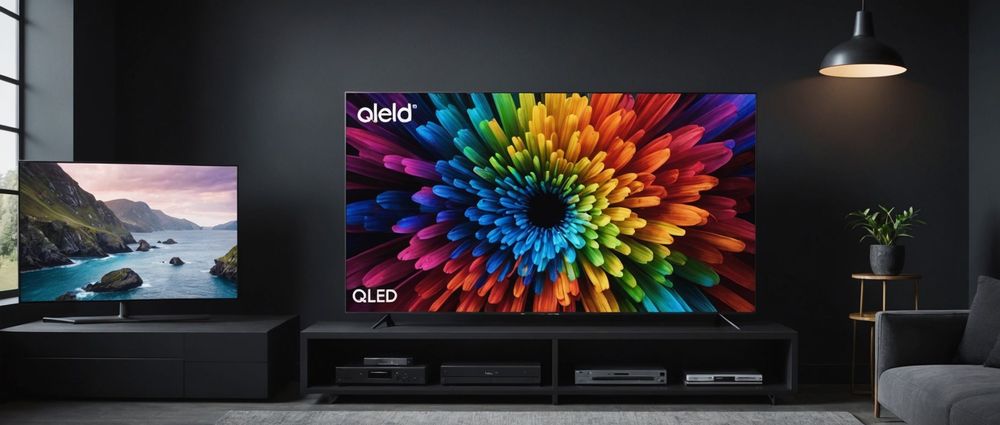How QLED and OLED TVs Are Different
When it comes to selecting a television, two of the most popular technologies in the market today are QLED and OLED. While both offer stunning picture quality and advanced features, they operate on fundamentally different principles. In this article, we’ll dive into the distinct characteristics of QLED and OLED TVs, exploring their differences in terms of technology, picture quality, brightness, viewing angles, and overall value. Understanding these differences can help consumers make informed decisions when choosing their next television.
Understanding QLED Technology

QLED, or Quantum Dot Light Emitting Diodes, represents a technology developed primarily by Samsung. QLED TVs use a quantum dot filter in conjunction with an LED backlight to produce vibrant colors and high brightness levels. These layers work together to enhance the color and brightness of the display. Notably, QLED provides excellent performance in well-lit rooms due to its ability to reach higher brightness levels, which helps prevent washed-out images.
Additionally, QLED TVs have a longer lifespan than their OLED counterparts because they utilize inorganic materials, making them more resistant to screen burn-in. This means viewers can enjoy their favorite content without worrying about ghost images lingering on the screen. QLED TVs also typically offer a wider selection of sizes and price points, catering to a broader audience. This technology often shines in fast-paced action movies or sports where bright images and vivid colors are essential.
Exploring OLED Technology

On the other hand, OLED, which stands for Organic Light Emitting Diodes, employs a different mechanism entirely. Each pixel in an OLED screen emits its own light, allowing for more precise control over brightness and color. This self-emissive technology results in deep blacks and superior contrast since pixels can be turned off individually. This characteristic is especially beneficial for dark scenes in movies or shows, as the blacks appear truly black rather than gray.
Moreover, OLED offers exceptional viewing angles, meaning that the colors and brightness remain consistent even when viewed from the side. This feature makes OLED TVs ideal for group watching and home theaters. However, potential drawbacks include the risk of temporary and permanent burn-in, particularly if static images are displayed for extended periods. Despite these risks, many enthusiasts praise OLED for its unparalleled picture quality and nuanced colors, especially for cinematic experiences.
Picture Quality and Color Performance Comparison
The picture quality of QLED and OLED TVs differs significantly due to their technologies. QLED excels in brightness and can produce vibrant colors, making it a great choice for brightly lit rooms. In contrast, OLED’s true blacks and superior contrast ratios elevate its performance in dark environments, delivering a more immersive viewing experience.
This leads us to a crucial aspect: color performance. Here’s how each technology fares:
- QLED: Produces bright, vivid colors under well-lit conditions, ideal for daytime viewing.
- OLED: Offers richer colors and deeper blacks, perfect for cinema-style experiences in dark rooms.
- Color Volume: QLED excels in color volume and brightness, while OLED provides more accurate colors in darker settings.
Each technology has its strengths and weaknesses, so the ideal choice often depends on the viewer’s environment and preferences.
Brightness and Viewing Angles
Brightness is another area where QLED tends to surpass OLED. As mentioned, QLED TVs can achieve higher peak brightness levels, making them excellent for well-lit spaces. This advantage becomes particularly noticeable during bright daytime viewing, where ambient light might wash out the colors on an OLED display. On the flip side, OLED TVs often struggle with brightness in such environments, which can lead to a less satisfying viewing experience.
When it comes to viewing angles, OLED has a clear advantage. The self-emissive nature of OLED technology allows for incredible viewing angles without color distortion. Viewers can enjoy a consistent picture quality from various angles, providing more flexibility in room arrangements. In contrast, QLED displays may show a decline in color accuracy and brightness when viewed from off angles, making them less ideal for group settings or informal viewing parties.
Cost and Value Considerations
Pricing plays an integral role when comparing QLED and OLED TVs. Generally, QLED TVs are positioned as a more affordable option for consumers seeking high-quality displays. This technology typically has a wider range of sizes and prices, making it accessible for various budgets. Additionally, QLED may offer more budget-friendly basic models, which can be appealing for those who prioritize value over the utmost in picture quality.
In comparison, OLED TVs often come with a higher price tag due to the costs associated with manufacturing the organic materials used in their panels. However, many consumers justify the investment in an OLED screen for its superior picture quality, immersive viewing experience, and remarkable color accuracy. Ultimately, the decision often hinges on how much importance a buyer places on cutting-edge display technology versus budget considerations.
Conclusion
In summary, both QLED and OLED TVs showcase remarkable advancements in display technology, each offering unique benefits that cater to differing viewing preferences and environments. QLED is an excellent choice for bright spaces, offering high brightness and vibrant colors, while OLED excels in delivering deep blacks and unparalleled picture quality, particularly in darker settings. Understanding these differences allows consumers to make informed choices that align with their viewing habits, room lighting conditions, and budget. Ultimately, whether QLED or OLED is the right fit will depend on personal preferences, but both technologies provide stunning visual experiences worth considering.
FAQs
1. Which is better for gaming, QLED or OLED?
Both QLED and OLED TVs offer excellent gaming experiences, but OLED can have lower input lag and superior contrast. However, burn-in is a risk with OLED; if you’re concerned about long gaming sessions with static images, QLED may be the safer option.
2. Can QLED TVs achieve true blacks?
No, QLED TVs cannot achieve the true blacks of OLED because they rely on backlighting. However, they can get very close, particularly in dimming technologies that reduce light leakage.
3. Do QLED TVs suffer from burn-in?
No, QLED TVs do not suffer from burn-in as they use inorganic materials. Users can display static images without the fear of permanent screen damage.
4. How long do OLED and QLED TVs typically last?
QLED TVs generally have a longer lifespan due to their use of durable materials. OLED TVs may last around 5-7 years, while QLED can often last upwards of 10 years with proper care.
5. Are both technologies 4K capable?
Yes, both QLED and OLED TVs are available in 4K resolutions, providing stunning clarity and detail for all types of content, from movies to video games.
